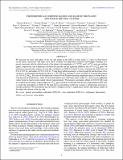PHOTOMETRICALLY DERIVED MASSES AND RADII OF THE PLANET AND STAR IN THE TrES-2 SYSTEM
Author(s)
Barclay, Thomas; Huber, Daniel; Rowe, Jason F.; Fortney, Jonathan J.; Morley, Caroline V.; Quintana, Elisa V.; Fabrycky, Daniel C.; Barentsen, Geert; Bloemen, S.; Christiansen, Jessie L.; Demory, Brice-Olivier; Fulton, Benjamin J.; Jenkins, Jon M.; Mullally, Fergal; Ragozzine, Darin; Seader, Shaun E.; Shporer, Avi; Tenenbaum, Peter; Thompson, Susan E.; ... Show more Show less
DownloadBarclay-2012-PHOTOMETRICALLY DERI.pdf (1.707Mb)
PUBLISHER_POLICY
Publisher Policy
Article is made available in accordance with the publisher's policy and may be subject to US copyright law. Please refer to the publisher's site for terms of use.
Terms of use
Metadata
Show full item recordAbstract
We measure the mass and radius of the star and planet in the TrES-2 system using 2.7 years of observations by the Kepler spacecraft. The light curve shows evidence for ellipsoidal variations and Doppler beaming on a period consistent with the orbital period of the planet with amplitudes of 2.79 [superscript +0.44] [subscript –0.62] and 3.44 [superscript +0.32] [subscript –0.37] parts per million (ppm), respectively, and a difference between the dayside and the nightside planetary flux of 3.41[superscript +0.55] [subscript –0.82] ppm. We present an asteroseismic analysis of solar-like oscillations on TrES-2A which we use to calculate the stellar mass of 0.94 ± 0.05 M [subscript ☉] and radius of 0.95 ± 0.02 R [subscript ☉]. Using these stellar parameters, a transit model fit and the phase-curve variations, we determine the planetary radius of 1.162[superscript +0.020] [subscript –0.024] R[subscript Jup] and derive a mass for TrES-2b from the photometry of 1.44 ± 0.21 M [subscript Jup]. The ratio of the ellipsoidal variation to the Doppler beaming amplitudes agrees to better than 2σ with theoretical predications, while our measured planet mass and radius agree within 2σ of previously published values based on spectroscopic radial velocity measurements. We measure a geometric albedo of 0.0136[superscript +0.0022] [subscript –0.0033] and an occultation (secondary eclipse) depth of 6.5 [superscript +1.7] [subscript –1.8] ppm which we combined with the day/night planetary flux ratio to model the atmosphere of TrES-2b. We find that an atmosphere model that contains a temperature inversion is strongly preferred. We hypothesize that the Kepler bandpass probes a significantly greater atmospheric depth on the night side relative to the day side.
Date issued
2012-11Department
Massachusetts Institute of Technology. Department of Earth, Atmospheric, and Planetary SciencesJournal
Astrophysical Journal
Publisher
IOP Publishing
Citation
Barclay, Thomas, Daniel Huber, Jason F. Rowe, Jonathan J. Fortney, Caroline V. Morley, Elisa V. Quintana, Daniel C. Fabrycky, et al. “PHOTOMETRICALLY DERIVED MASSES AND RADII OF THE PLANET AND STAR IN THE TrES-2 SYSTEM.” The Astrophysical Journal 761, no. 1 (November 21, 2012): 53. © 2012 The American Astronomical Society
Version: Final published version
ISSN
0004-637X
1538-4357